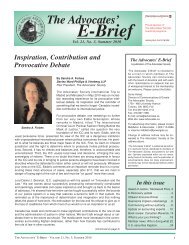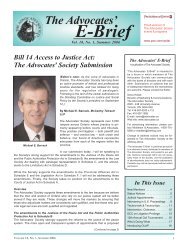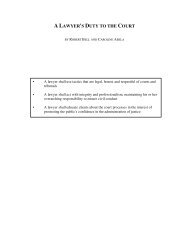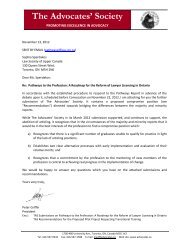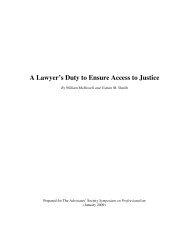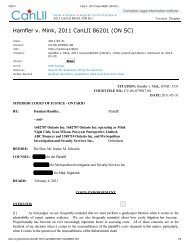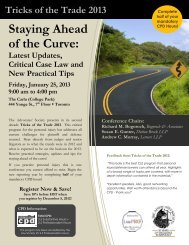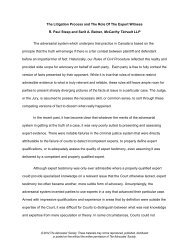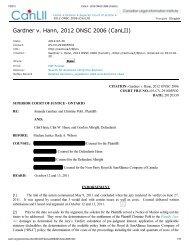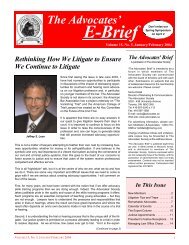History Cover & Text.qxp - The Advocates' Society
History Cover & Text.qxp - The Advocates' Society
History Cover & Text.qxp - The Advocates' Society
Create successful ePaper yourself
Turn your PDF publications into a flip-book with our unique Google optimized e-Paper software.
could be written, produced andmailed at a relatively low cost, butwould not involve itself in thelonger and more detailed articlesthat were the provenance of theJournal. Terrence J. O'Sullivan waschosen to head the project and heserved as co-editor, with JohnEvans, Q.C. and Heather Ford, ofthe first volume of issues. In comingyears, the “Brief” would pass intothe hands of other equally dedicatededitors, including Sandra J.Simpson, Patricia D.S. Jackson,Elizabeth M. Stewart, Lynda C.E.Tanaka, Sarah E. Pepall, Jeff G.Cowan and Robyn M. Ryan Bell.And finally, by-laws were draftedthat would have the effect of allowingyounger members into the<strong>Society</strong>, with the conditions of membershipreduced to allow greaterflexibility to the procedure.In other notable events in this session,the prospect of a federal salestax on legal services reared its uglyhead, a first indication to prescientmembers of the soon-to-be-hatchedGoods and Services Tax; a specialissue of the Journal was publishedfor distribution at the American BarAssociation Convention held inToronto; a Board of Directors meetingwas held in Hamilton, and the<strong>Society</strong> was active in <strong>The</strong> AttorneyGeneral's Conference on Access toJustice. <strong>The</strong> <strong>Society</strong> was representedon a committee considering theissue of paralegals, the ZuberCommittee and the PritchardCommittee were on-going and, onNovember 24, 1988, the <strong>Society</strong>'sdonated stained glass window,"English Heritage," was dedicated inConvocation Hall at Osgoode Hall.<strong>The</strong> End of Term Dinner featuredthe Honourable Justice Peter de C.Cory of <strong>The</strong> Supreme Court ofCanada, who recounted significantcases throughout history and highlightedthe role of the advocate ineach instance.As Peter G. Jarvis, Q.C. assumed thepresidency for the 1989-90 term, itbecame increasingly obvious that<strong>The</strong> <strong>Advocates'</strong> <strong>Society</strong> had evolvedinto a far different organization thanwas originally conceived. What wasforeseen by some members as anorganization for predominantlyToronto-based litigators -- a groupin which "every member knewevery other member" -- had growninto an expansive and dominantprofessional organization with aprovince-wide membership andwide-ranging goals and concerns.Such wide-ranging goals, optimisticobjectives and a multi-layered organizationalstructure broughtincreasing demands, responsibilitiesand especially costs. To fully fundthe many objectives of the <strong>Society</strong>required ever-increasing resources.Long-delayed improvements to thesecond and third floors of CampbellHouse were expected to cost in therange of $300,000. <strong>The</strong> <strong>Society</strong>'sdetermination to fight the government'sno-fault automobile insuranceplan with an injunction applicationled to President Jarvis and theBoard of Directors approving astipend of up to $25,000. <strong>The</strong>Advocates <strong>Society</strong> Institute, whilefulfilling the <strong>Society</strong>'s mandate tooffer educational programming,held the risk of suffering a heftyloss; despite a promising beginning,its fall programming was undersubscribed.And it was becomingincreasingly obvious that the skeletonstaff at the <strong>Society</strong>'s headquarterswas being stretched to the limitand that a new staff member or twowould have to be hired to assumesome of the load.<strong>The</strong> 1989-90 term, then, could beseen as something of a watershedyear, in which the <strong>Society</strong> couldeither continue to move boldly forward(at some financial risk), orslow down and assess its situation.In a way, it did both.At a Directors' retreat held atHorseshoe Valley in September1989, Roger Oatley's Long Range18Planning Committee held discussionson these issues and came upwith the following conclusions:• Renovations at Campbell Houseshould certainly push ahead. Delayshad been on-going for a decade, andwith every year that passed, expensesmounted.• <strong>The</strong> <strong>Society</strong> needed a membershipmarketing plan, because, withoutincreased membership, objectivescould not be met. This initiative ultimatelywould result in the creationof the Intermediate Member category,aimed at the lawyer who did notyet have five years of experience.• <strong>The</strong> <strong>Society</strong> needed to strengthenits commitment to the Institute andto build on the opportunities for collegialitythat it presented.• <strong>The</strong> <strong>Society</strong> needed to be more ofa "trade association," with the mandateto consider and confront policyissues facing it. "We need to beinvolved in the legislative process.We cannot afford to be 'amateurs.'We need to protect the role of advocatesin dispute resolution," theCommittee concluded.• <strong>Society</strong> staff was overtaxed. A secretarywas needed, bookkeepingcould be contracted out, and a newcomputer was required.• A sound business plan was needed.While this planning was underway,Tony Keith and Moishe Reiter, whohad been producing the Journalsince its debut, asked to be relievedof their responsibility. <strong>The</strong>ir finalissue was published in the TrinityTerm, June 1990.Undoubtedly, the highlight of thisterm was the 10-day InternationalConference in Moscow andLeningrad in May 1990. Because ofsignificant changes that were takingplace in the Soviet Union, as it thenwas, many areas of law and justicewere in a state of flux. Besides theobvious cultural attractions -- theBolshoi, Lenin's Tomb, the Kirov<strong>The</strong>atre -- delegates had the opportunityto observe trials and visit



